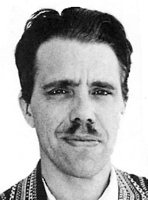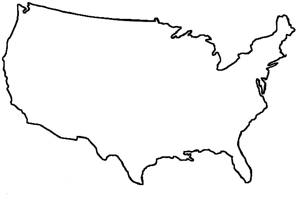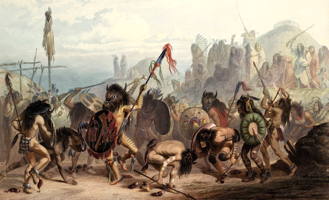
|
The Society of Folk Dance Historians (SFDH)
Native American Dance
[
Home |
About |
Encyclopedia | CLICK AN IMAGE TO ENLARGE |

|
 The word "Sioux" is a shortened and corrupted form of the French interpretation of an Ojibway or Cheyenne word "nadowessioux" that means "enemy" or "enemies," and is applied to a number of Plains Native Americans of the Sioux linguistic stock, and that includes the Winnebago, Iowa, Otoe, Ponca, Osage, etc. of the "Southern Sioux," as well as those more restrictively applied to the Dakotahs, which means "allies." These latter include the Yankton, Santee and Teton, that in turn include such recently aware-to-the-public groups as the Brule, Oglalas, and Rosebud. Many of the Sioux passed through, or still live in, the states of North and South Dakota, especially the latter.
The word "Sioux" is a shortened and corrupted form of the French interpretation of an Ojibway or Cheyenne word "nadowessioux" that means "enemy" or "enemies," and is applied to a number of Plains Native Americans of the Sioux linguistic stock, and that includes the Winnebago, Iowa, Otoe, Ponca, Osage, etc. of the "Southern Sioux," as well as those more restrictively applied to the Dakotahs, which means "allies." These latter include the Yankton, Santee and Teton, that in turn include such recently aware-to-the-public groups as the Brule, Oglalas, and Rosebud. Many of the Sioux passed through, or still live in, the states of North and South Dakota, especially the latter.
The Brule are one of the seven sub-bands of the Tetons. The word "Brule" is again French, and is in reference to a legend that the members of the group at one time were forced to run through a raging prairie fire and as a consequence, all of the people came through with burns. They are very proud, both in their way of life and in appearance. Their lives were centered on the hunt and in warring, seeking the best of everthing for their families, and mindful of their impressions on others. The Brule were more of a nomadic culture.
The Yankton Sioux were more like the Santees than the Tetons or Brule insofar as they lived a relatively settled existence (other than when being uprooted by the onward push of pioneer expansion). While their living quarters were often the usual skin-covered teepee, usually associated with the more nomadic cousins of the plains, they also used the less mobile "tiukan" or skin-covered house and permanent earth lodge.
 Dance plays a very prominent part in Sioux history, for it was just befor the Battle of Wounded Knee in South Dakota that the Sioux engaged in the "Ghost Dance." This dance became a kind of religious ceremony, even a religion in itself, and was originated by a Paiute in Nevada by the name of Wovoka. The dance was accompanied by special songs and chants that Wovoka contended would eventually cause the disappearance of the white people, restore the Native Americans who had died, and bring back the herds of bison. This was in the early 1880s, and it spread rapidly across the lands of the Plains Native Americans whom the U.S. Army was in the process of crushing. Fearing that the dance would have a fanatical influence on the groups of Native Americans, the Army sternly smashed out attempts at its perfomance, and many of Wovoka's followers among the Sioux were massacred at Wounded Knee.
Dance plays a very prominent part in Sioux history, for it was just befor the Battle of Wounded Knee in South Dakota that the Sioux engaged in the "Ghost Dance." This dance became a kind of religious ceremony, even a religion in itself, and was originated by a Paiute in Nevada by the name of Wovoka. The dance was accompanied by special songs and chants that Wovoka contended would eventually cause the disappearance of the white people, restore the Native Americans who had died, and bring back the herds of bison. This was in the early 1880s, and it spread rapidly across the lands of the Plains Native Americans whom the U.S. Army was in the process of crushing. Fearing that the dance would have a fanatical influence on the groups of Native Americans, the Army sternly smashed out attempts at its perfomance, and many of Wovoka's followers among the Sioux were massacred at Wounded Knee.
Another important ritual dance among the Plains Native Americans was the "Sun Dance," held annually during the summer months. Usually danced around a pole or sacred tree, the warrior-participants, in return for spiritual help, would dance quite simple steps and sometimes for days on end without food and water. Self-torture was often part of the ritual, and one particularly fearsome deed was to suspend oneself from the pole by means of skewers inserted in double slits on the skin of their chests or back-shoulders, then dance until they ripped free. A symbolic version of this dance is performed annually on the reservations at the present time, but the use of the skewers and piercing is forbidden.
It is interesting to note that dance and ceremony seem to be a common denominator (in some cases) of the Native Americans of the Americas. In the case of language, the difference between the groups of Native Americans is enormous. Compared with Europe, which has the Indo-European, the Finno-Ugric, and the small sole Basque family groups covering the entire continent, there are a number of major language families and literally hundreds of minor Basque-type languages unrelated to each other in this hemisphere, and thereby, incomprehensible to each other. Yet, we find legends, customs, and especially dances, spread across the land that are similar and in some cases almost identical. Obviously, they have been transmitted by interaction and communication other than verbal. Physical movement seems to be a language understood by all – a case of one picture being worth more than a thousand words.
DOCUMENTS
- Native American, a culture.
- Native American Affairs, an article.
- Native American Dances, an article.
- Navaho Tradition Keepers, an article.
- North America, a region.
Used with permission of the author.
Printed in Folk Dance Scene, November 1981.
This page © 2018 by Ron Houston.
Please do not copy any part of this page without including this copyright notice.
Please do not copy small portions out of context.
Please do not copy large portions without permission from Ron Houston.